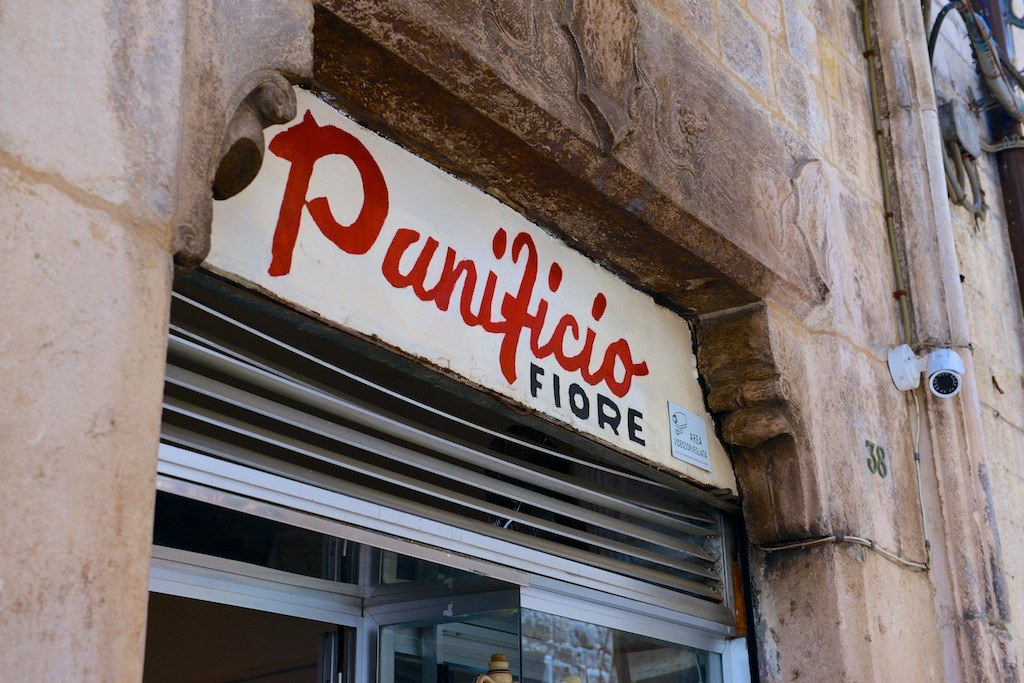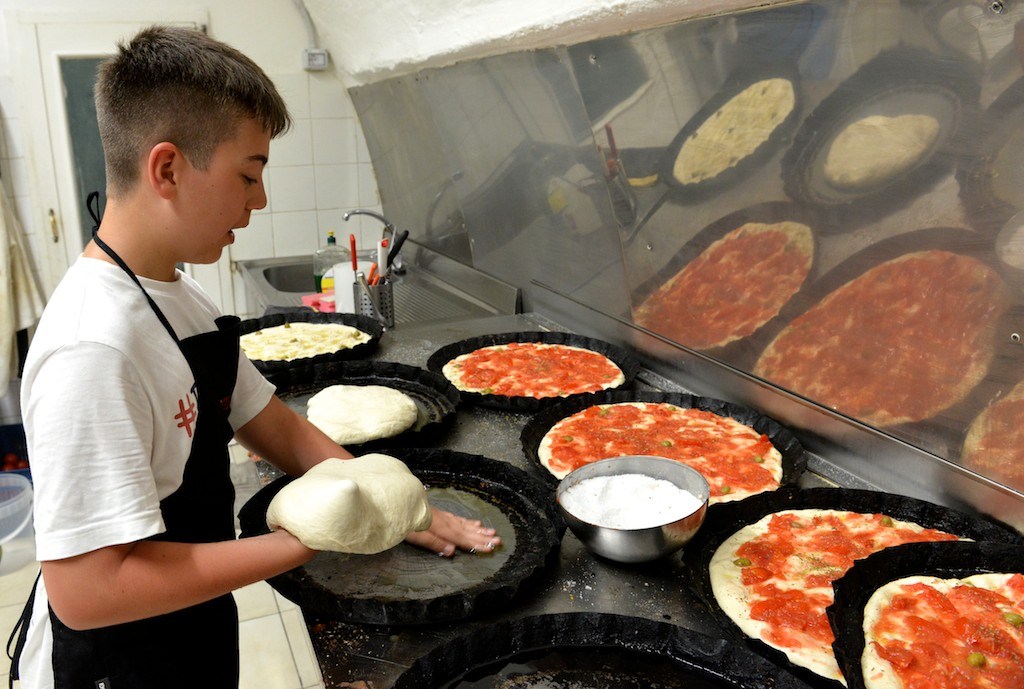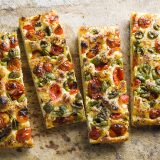The focaccia emerge from the oven—a truck-sized stone behemoth that radiates with breathtaking intensity—so quickly, the bakers at Panificio Fiore exhaust their shelves of cooling racks, forcing them to line the pans along the white tiled floor as they use a 14-foot peel to rapid-fire reload and bake the next batch.
The century-old wood-fired oven can hold 48 focaccia at once, baking them in just over 10 minutes. Even then, making hundreds a day, the workers can’t keep pace with the lunch line that twists out the tiny shop and down one of the many winding stone alleys of Bari, a thin strip of a city along the Adriatic Sea on the heel of the Italian boot. Over and again, they hand the focaccia to Antonio Fiore, whose grandfather opened the shop in 1940.
Standing at the front counter, customers blurting orders at him, Fiore tosses each foot-round focaccia onto a concave stainless steel slab—designed to allow excess olive oil to drip away—then uses a long serrated knife to cut wedges to order, wrapping them in parchment before handing over the still-warm hunks dotted with crushed tomatoes and glistening whole green olives.
In the midst of the rush, he hands me a thick wedge, oil staining the paper and slicking my fingers. It is shockingly crispy and lightly crunchy on the bottom—almost shattering—yet the top remains airy-chewy and tender, with bursts of brine and juicy sweet tomato. It is unlike any focaccia I’ve eaten, all too often singularly and unappealingly dense and doughy, lacking texture or definition. Fiore’s is rich with contrasts, fried in parts, baked in others.
With each crunchy-chewy bite I understand all the more why his focaccia recently was named the best in all of Italy. Less clear was how he managed to make it so good. And so different.
"With each crunchy-chewy bite I understand all the more why his focaccia recently was named the best in all of Italy."
Tucked amongst the arches of Pontifical Basilica di San Nicola, Panificio Fiore occupies a former crypt that dates to at least 1508. Its white stone walls and columns are plastered with pictures of the church’s namesake St. Nicholas.
A long glass display case offers a dozen varieties of focaccia, many with wedges already hacked out. Bianca (just olives); cipolle e pomodoro (onion and tomato); melanzane e pomodoro (eggplant and tomato); patate, pomodoro e carciofi (potato, tomato and artichoke); and pomodoro, formaggio e rucola (tomato, cheese and arugula) among them. But the most popular—and that which the bakers today labor at—is pomodoro e olive, or tomato and olives.
Focaccia is the street food of Bari, a meal intended to be eaten immediately; it is fresh for only a few hours. Fiore complains that other bakers make more and make them faster, but that’s not traditional—and you can taste their shortcuts. To show me the right way, he guides me into the kitchen, where waves of heat and yeast wash over you.
As Fiore rattles off the main ingredients—flour, yeast, water, salt and olive oil—nothing strikes me as unusual, nothing that can account for the delicious push-and-pull of tender-crispy that makes his focaccia so memorably good. Turns out, the difference isn’t in the what, but in the how. Particularly, how long and how much.
On one side of the room, dough rises in containers the size of trash cans. The bakers—all of them family—hoist the buckets of dough, dumping it in large, almost oozing piles onto metal tables for portioning. The dough is tender and flabby and barely can be handled. That’s the first clue—the ratio of water to dry ingredients clearly is higher than normal.
A typical focaccia dough uses water equal to about 56 percent of the weight of flour used. Fiore’s recipe clocks in at more than 90 percent water to flour. That difference is critical because wet doughs produce weaker gluten, the protein that gives most baked goods their structure. Weak gluten tears easily, especially when all that excess moisture in the dough turns to steam in the oven. The combination creates an airy, open and more tender crumb.
An equally important difference turns out to be timing. While a typical focaccia might rise for one to two hours, Fiore’s rises for four hours, during which the dough rises, falls, then rises again, a process that leaves it looking and feeling blown out. This produces more gas than a shorter rise. Though some of that gas depletes over time—resulting in less dramatic oven spring when the focaccia first hits the hot oven—the remaining gas, combined with the steam and gluten structure, creates more and larger air pockets in the dough.
The source of the crisp bottom—not merely browned, as with a pizza, but almost crackling—becomes clear as the dough is portioned into dark metal pans. Olive oil so copious it sloshes up the side of the dough goes into the pan first, effectively frying the bottom of the focaccia as the top bakes.
Back at Milk Street, adapting the recipe mostly was a matter of logistics. In the heat of Fiore’s kitchen, four hours is plenty for rising. But in significantly cooler home kitchens, we needed to let the dough go for about six hours to get similar results. And without the benefit of a wood-fired oven that can crank upward of 600°F, we needed to bake our focaccia a bit longer.
We also needed a substitute for the tomatoes. Lightly crushed cherry tomatoes offered the best flavor in place of the almost iridescent Sicilian tomatoes Fiore used. Halving them, then lightly mashing them removed some of the juices that otherwise pooled unappealingly on the surface of the focaccia. The result? Italy’s best focaccia a little closer to home.
More from Puglia






